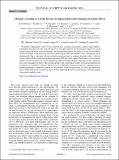Files in this item
Meissner screening as a probe for inverse superconductor-ferromagnet proximity effects
Item metadata
| dc.contributor.author | Flokstra, Machiel Geert | |
| dc.contributor.author | Stewart, Rhea | |
| dc.contributor.author | Satchell, Nathan | |
| dc.contributor.author | Burnell, Gavin | |
| dc.contributor.author | Luetkens, Hubertus | |
| dc.contributor.author | Prokscha, Thomas | |
| dc.contributor.author | Suter, Andreas | |
| dc.contributor.author | Morenzoni, Elvezio | |
| dc.contributor.author | Lee, Steve | |
| dc.date.accessioned | 2021-08-24T15:30:13Z | |
| dc.date.available | 2021-08-24T15:30:13Z | |
| dc.date.issued | 2021-08-20 | |
| dc.identifier | 275293874 | |
| dc.identifier | ca9a08f1-d0c7-4ee7-8909-cca2b7e40b9f | |
| dc.identifier | 000686910000005 | |
| dc.identifier | 85114012780 | |
| dc.identifier.citation | Flokstra , M G , Stewart , R , Satchell , N , Burnell , G , Luetkens , H , Prokscha , T , Suter , A , Morenzoni , E & Lee , S 2021 , ' Meissner screening as a probe for inverse superconductor-ferromagnet proximity effects ' , Physical Review. B, Condensed matter and materials physics , vol. 104 , no. 6 , L060506 . https://doi.org/10.1103/PhysRevB.104.L060506 | en |
| dc.identifier.issn | 1098-0121 | |
| dc.identifier.other | ORCID: /0000-0002-2020-3310/work/99115865 | |
| dc.identifier.other | ORCID: /0000-0002-4333-1358/work/99116100 | |
| dc.identifier.uri | https://hdl.handle.net/10023/23823 | |
| dc.description | Funding: We acknowledge the support of the EPSRC through Grants No. EP/I031014/1, No. EP/J01060X, No. EP/J010634/1, No. EP/L015110/1, No. EP/R031924/1, and No. EP/R023522/1. This project has received funding from the European Union’s Horizon 2020 research and innovation programme under the Marie Skłodowska-Curie Grant Agreement No. 743791 (SUPERSPIN). R.S. acknowledges funding under ETH Zurich Postdoctoral Fellowship 20-1FEL-36. | en |
| dc.description.abstract | We present experimental results on the observed flux screening in proximity coupled superconductor-ferromagnet thin film structures using Nb and Co as the superconductor and ferromagnet respectively. Using the low-energy muon-spin rotation technique to locally probe the magnetic flux density, we find that the addition of the ferromagnet (F) increases the total flux screening inside the superconductor. Two contributions can be distinguished. One is consistent with the predicted spin-polarization (or magnetic proximity) effect, while the other is in line with the recently emerged electromagnetic (EM) proximity models. Furthermore, we show that the addition of a few nanometers of a normal metallic layer between the Nb and the Co fully destroys the contribution due to electromagnetic proximity. This is unanticipated by the current theory models in which the magnetization in the F layer is assumed to be the only driving force for the EM effect and suggests the role of additional factors. Further experiments to explore the influence of the direction of the F magnetization also reveal deviations from theory. These findings are an important step forward in improving the theoretical description and understanding of proximity coupled systems. | |
| dc.format.extent | 6 | |
| dc.format.extent | 399328 | |
| dc.language.iso | eng | |
| dc.relation.ispartof | Physical Review. B, Condensed matter and materials physics | en |
| dc.subject | QC Physics | en |
| dc.subject | TK Electrical engineering. Electronics Nuclear engineering | en |
| dc.subject | DAS | en |
| dc.subject.lcc | QC | en |
| dc.subject.lcc | TK | en |
| dc.title | Meissner screening as a probe for inverse superconductor-ferromagnet proximity effects | en |
| dc.type | Journal item | en |
| dc.contributor.sponsor | EPSRC | en |
| dc.contributor.sponsor | EPSRC | en |
| dc.contributor.sponsor | EPSRC | en |
| dc.contributor.sponsor | EPSRC | en |
| dc.contributor.institution | University of St Andrews. School of Physics and Astronomy | en |
| dc.contributor.institution | University of St Andrews. Centre for Designer Quantum Materials | en |
| dc.contributor.institution | University of St Andrews. Condensed Matter Physics | en |
| dc.identifier.doi | 10.1103/PhysRevB.104.L060506 | |
| dc.description.status | Peer reviewed | en |
| dc.identifier.grantnumber | EP/I031014/1 | en |
| dc.identifier.grantnumber | EP/J01060X/1 | en |
| dc.identifier.grantnumber | EP/R031924/1 | en |
| dc.identifier.grantnumber | EP/R023522/1 | en |
This item appears in the following Collection(s)
Items in the St Andrews Research Repository are protected by copyright, with all rights reserved, unless otherwise indicated.

